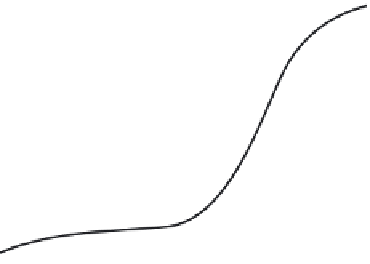Graphics Reference
In-Depth Information
Environmental light
−
S
d
q
S
d
p
Figure 10.6
The interreflection pass in precomputation.
Because light is additive, the interreflection can be computed separately. At
a particular sample point
p
, the first interreflection pass works as follows. For
a set of samples over the hemisphere, rays are cast to test for intersection with
the object. Suppose a ray originating at
p
hits the object at another point
q
.The
directly reflected radiance from
q
to
p
is computed from the transfer matrix that
was computed in the previous pass: the incident radiance at a sample ray of direc-
tion
sample rays over the hemisphere from
p
are used to construct the indirect transfer
matrix at
p
. The interreflection pass can be repeated using the indirect transfer
matrices from the previous interreflection pass to determine the radiance values at
the surface intersections. Pass
N
thus includes light reflected from exactly
N
s
d
is the outgoing radiance at
−
1
bounces, so the outgoing radiance can be expected to drop at each pass. The
process is terminated when the values fall below a certain threshold. The final
transfer matrix at each point is the sum of all the computed transfer matrices from
the
N
passes.
For an order-
n
SH expansion, each light vector has
n
2
elements, which means
each transfer matrix has
n
4
elements. One such matrix has to be computed and
stored for each sample point on the surface. While this may seem daunting, the
assumption of low-frequency lighting and reflection limits the size of the light
vectors. The authors demonstrate that approximations of order four or five are
sufficient to capture most of the shadowing effects. The
n
−
5 case has light vec-
tors of dimension 25 and transfer matrices of 625 elements. By modern standards,
these are not large; however, matrix multiplication involving anything larger than
4
=
4 matrices was difficult or impossible on GPUs available in 2002 when the
original paper was written. For this reason, the surfaces were first assumed to be
Lambertian. In this case, the outgoing radiance is constant and the transfer matrix
×






















